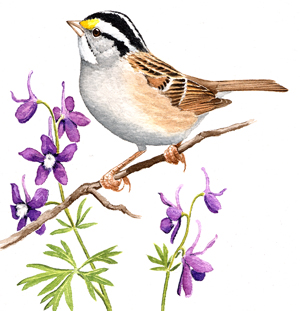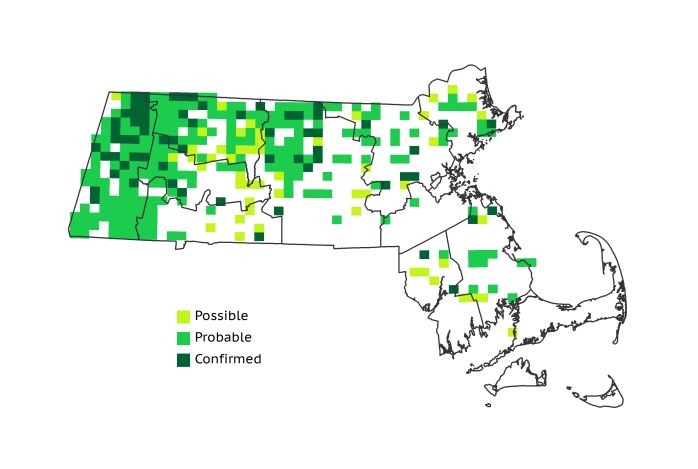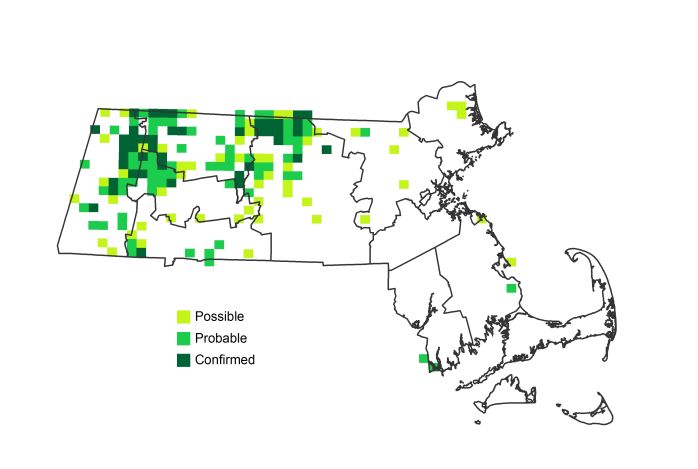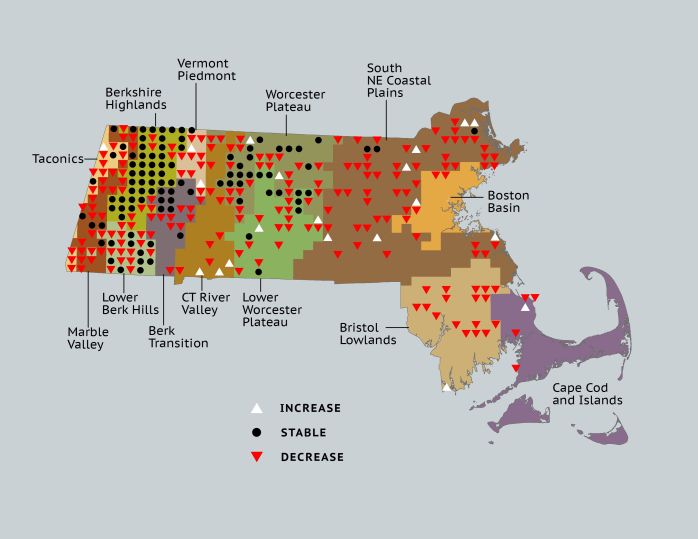Breeding Bird Atlases (BBA)
Find a Bird
White-throated Sparrow
Zonotrichia albicollis

Local and strongly declining
Conservation action urgent
State Wildlife Action Plan listed
“The note of the white-throated sparrow, a very inspiriting but almost wiry sound, was first heard in the morning, and with this all the woods rang.” – Henry David Thoreau, The Maine Woods
The White-throated Sparrow is a handsome and well-known bird of northern young forests. Often considered an icon of the northern woods, its clearly whistled song is widely recognized, but indications are that the species is in serious decline. White-throated Sparrows have been whistling the lament of Poor Sam Peabody for longer than anyone can remember, but who in the future will sing the lament of the White-throated Sparrow?
Historic Status
Historical confusion between late migrants and actual breeders has lent an air of mystery to the status of the White-throated Sparrow in the Commonwealth. The “Peabody Bird” was known to the earliest recorders of birdlife in Massachusetts as a migrant that passed through the state during a brief two-week period before moving to the far north (Peabody 1839). A half century later, the species had become both an occasional resident in winter and a well-known breeder, the latter specifically concentrated at the higher elevations of the northern central and western parts of the state (Howe & Allen 1901). Edward Howe Forbush described the White-throated Sparrow as “breeding locally on western and northern highlands and sporadically elsewhere; rare winter residents, chiefly coastwise,” (Forbush 1929).
Atlas 1 Distribution
White-throated Sparrows bred in many parts of the state during Atlas 1, occupying 35% of the blocks surveyed, but the nexus of breeding activity was plainly in the western highlands. The Berkshire Highlands and Lower Berkshire Hills resounded with the refrain of Poor Sam Peabody across more than 90% of the blocks in each ecoregion, in contrast to the stark distribution gap posed by the Connecticut River Valley with only 20% of the blocks occupied. The Worcester Plateau showed a considerable concentration of breeding activity, though relatively few birds spilled over into the Lower Worcester Plateau. White-throated Sparrows were scattered and irregular in their breeding distribution throughout the Coastal Plains, Boston Basin, and Bristol/Narragansett Lowlands.
Atlas 2 Distribution and Change
Habitat loss may be mostly to blame for the sharp decline, to only 16% of the blocks surveyed, in the breeding presence of White-throated Sparrows in Massachusetts. Losses were widespread and were in every region of the state. The effort-controlled data showed a net loss for the species in 182 blocks, or 22% of the blocks in that data set. The wholesale loss of the species from the eastern reaches of the state is troubling, and despite concerns of methods it is a fact that all blocks in which they were Confirmed during Atlas 1 in the eastern reaches of the state no longer have breeding White-throated Sparrows.
Atlas 1 Map

Atlas 2 Map

Atlas Change Map

Ecoregion Data
Atlas 1 | Atlas 2 | Change | ||||||
Ecoregion | # Blocks | % Blocks | % of Range | # Blocks | % Blocks | % of Range | Change in # Blocks | Change in % Blocks |
Taconic Mountains | 14 | 87.5 | 4.2 | 4 | 16.0 | 2.4 | -9 | -60.0 |
Marble Valleys/Housatonic Valley | 28 | 71.8 | 8.3 | 7 | 17.9 | 4.2 | -21 | -53.8 |
Berkshire Highlands | 52 | 94.5 | 15.5 | 41 | 74.5 | 24.7 | -11 | -20.8 |
Lower Berkshire Hills | 27 | 96.4 | 8.0 | 11 | 35.5 | 6.6 | -16 | -59.3 |
Vermont Piedmont | 13 | 76.5 | 3.9 | 6 | 35.3 | 3.6 | -7 | -58.3 |
Berkshire Transition | 23 | 60.5 | 6.8 | 12 | 30.0 | 7.2 | -12 | -38.7 |
Connecticut River Valley | 11 | 19.6 | 3.3 | 5 | 7.7 | 3.0 | -6 | -12.5 |
Worcester Plateau | 58 | 74.4 | 17.3 | 48 | 54.5 | 28.9 | -19 | -39.6 |
Lower Worcester Plateau | 31 | 41.9 | 9.2 | 16 | 20.0 | 9.6 | -16 | -29.6 |
S. New England Coastal Plains and Hills | 54 | 20.0 | 16.1 | 13 | 4.6 | 7.8 | -42 | -18.6 |
Boston Basin | 4 | 7.1 | 1.2 | 0 | 0.0 | 0.0 | -4 | -7.3 |
Bristol and Narragansett Lowlands | 17 | 16.0 | 5.1 | 2 | 1.8 | 1.2 | -16 | -15.8 |
Cape Cod and Islands | 4 | 2.9 | 1.2 | 1 | 0.7 | 0.6 | -3 | -2.5 |
Statewide Total | 336 | 34.7 | 100.0 | 166 | 16.0 | 100.0 | -182 | -22.0 |
Notes
In accordance with Atlas decreases, the White-throated Sparrow shows significant decreasing Breeding Bird Survey trends in Massachusetts, in the New England/Mid-Atlantic Region, and in the Eastern US overall. Divining this species’ true status in Massachusetts may suffer more than many others from a protocol design flaw during Atlas 1. Atlas 1 did not ask Atlas workers to consider Safe Dates. As such, notorious late migration lingerers that they are, White-throated Sparrows with no intention of breeding in the state may have been recorded as Possible or Probable nesters, when they were indeed late migrants. The dates of each of the Atlas 1 observations were not recorded, and as such the effect of this design flaw is not known.



